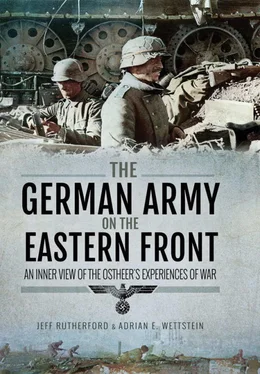Positional warfare brings the danger that a slackening occurs too easily. This danger must be universally combated.
First and foremost, the troops’ spirit of the attack and their feelings of superiority towards the Russians need to be promoted.
The will for action and for work must be emphasized, when necessary through a hard grip. Other than that, recognition in any form.
The very fact that a panzer commander spoke about the need to maintain a ‘wall’ spoke volumes about conditions on the northern and central sectors of the Eastern front; clearly the German approach to combat was in a state of transformation. This emerged from the statement on ‘meddling’. What was once seen as interfering with a commander’s prerogative on the battlefield was now seen as a necessity, due both to the larger context of the war in the east and to the loss of experienced commanders who had been replaced by ‘weak ones’. Finally, the commander’s emphasis on the importance of will reflected a larger trend within the army that looked to balance out the Red Army’s growing quantitative and in some cases qualitative superiority with the supremacy of the individual German soldier, an issue further addressed in chapter 7.
In addition to its primary mission of fighting the Red Army on the battlefield, the army also found itself increasingly engaged in combat in the rear area, fighting an ever-burgeoning partisan movement. [39]This insurgency proved especially intractable in the centre of the front, as the large forests and swamps offered numerous areas for partisan bands to regroup and hide. German anti-partisan policy evolved by 1943 into one in which large operations had become the standard response. Involving various formations – including front-line panzer and infantry divisions – these were true military operations that looked to encircle and destroy insurgent groups. [40]The following report concerning the outcome of Operation ‘Gypsy Baron’ provides a look at the partisan threat facing the army and the Germans’ response to it. [41]
1) Operation ‘Gypsy Baron’ is concluded except for Group Bornemann’s cleansing out of the corner Ssov-Nerusea on 6.6.43. In combat against a devious enemy with tremendous terrain difficulties in a swampy, heavily-mined forest area, the troops succeeded through considerable exertions in annihilating the majority of the gangs [42]in the area south of Briansk, destroying their shelters and seizing a large amount of goods.
[…]
8) Enemy losses and seized goods during Operation ‘Gypsy Baron’:
1,525 prisoners
869 deserters
1,536 enemy dead, the number of dead in reality will be substantially higher as it has been determined that the gangs buried their dead immediately after battle
15,801 evacuated civilians
201 destroyed camps
2,915 destroyed bunkers and battle positions
9 pistols […]
1,093 rifles, of which 175 were [semi-]automatic, 26 gun barrels
87 machine pistols
123 machine guns, outside of numerous machine gun mounts and drums […]
55 mortars
14 anti-tank guns, 2 anti-tank gun barrels […]
9 light guns
12 heavy guns
3 tanks, including 1 T-34
2 armoured scout cars
2 planes, including one with telephone and radio equipment […]
165,720 rounds of rifle ammunition
Around 30,000 rounds of machine gun ammunition
11,000 rounds of heavy machine gun ammunition […]
183 sleds
316 horses
380 cows
717 panje wagons
Clothing and equipment for some 500 men
The complexity of the partisan war emerges clearly from this document. On the one hand, the partisan movement possessed the military means to threaten German lines of communication and supply, as well as the troops themselves. In addition to large numbers of small arms, machine guns, and considerable quantities of ammunition, German troops seized artillery pieces, tanks, armoured cars and even two planes (of course whether any of the latter were operational was left unsaid). On the other hand, German losses for the operation were quite small, suggesting that it was not characterized by pitched battles. [43]In contrast, Soviet casualties of over 1,500 dead suggest that the army’s pacification policies frequently degenerated into arbitrary murder of civilians. The economic aspect of the operation also clearly emerges as cows, horses, wagons, and, most importantly, nearly 16,000 civilians were deported to the German rear for their use. This report therefore demonstrated the ways in which German military and economic goals – influenced by Nazi ideological beliefs – were inextricably entwined on the Eastern front. It also illustrated the various tasks that an increasingly strained and under-manned German army was being called on to complete. Since the army found it extremely difficult to adequately train its men for the multiplicity of these missions, violence frequently became the foundation of those – such as anti-partisan policy – which were deemed secondary to its primary task of combat.
July 1943 witnessed the last gasp of German offensive warfare during the Battle of Kursk. The scaling down of German goals for this offensive clearly indicated that the army had severely bled during the preceding years of war. Instead of an offensive designed to destroy the entirety of the Red Army and Soviet state, as in 1941, or one predicated on seizing the Caucasus oil fields and hopefully smashing the remaining Soviet power sent to defend the southern wing in 1942, the objective in 1943 was much more modest. It centred on ironing out a Soviet bulge in the line and destroying Soviet offensive capabilities, thus freeing German troops for use as a reserve both in the East and for deployment in other threatened theatres. Postponed several times due to the desire to introduce the Panther and Tiger tanks to the battlefield, the Germans lost any element of surprise and the battle closely resembled the attritional warfare of the First World War, albeit fought with the primary weapons of the Second World War – tanks, planes in the role of tank hunters, and ATGs. [44]While the decisive engagement of the battle was fought on the southern wing, it was the failure of Ninth Army’s attack on the northern wing that ultimately doomed the offensive. The 7th Infantry Division, located on the far left shoulder of Ninth Army’s advance, went onto the attack on 5 July and, though it reached its goals on the first day, subsequent attacks in the following days made very limited progress; by 16 July, the division had been withdrawn from the offensive in order to meet a major Soviet counterattack launched against the Orel bulge. For the next three and a half weeks, the division participated in costly defensive fighting against the Red Army until it took up positions in the Hagen Line in mid-August. The following monthly status divisional report was sent to its superior corps on 1 August 1943 and details the effects of such heavy fighting on the unit and its combat efficiency. [45]
1. Personnel Situation on cut-off date of report: 1.8.43
a) Missing ranks: 95 officers (of which 14 are medics, 3 veterinarians, 9 officials)
492 NCOs
2,822 Men
180 Hiwi [46]
b) casualties and other departures in the reporting period from 1.7.43 to 31.7.43
officers: 23 dead, 100 wounded, 3 missing, 4 sick, 6 left for other reasons
NCOs and men: 518 dead, 2,997 wounded, 165 missing, 194 sick, 111 left for other reasons
c) replacements who arrived during the reporting period
officers: 11 replacements, 4 convalescents
NCOs and men: 780 replacements, 196 convalescents. […]
3. Value Judgement of the Commander
1) Combat Value
The division has been in large-scale fighting for one month. The hard fighting during Operation Citadel, the extremely difficult actions of the division in defending the enemy’s major offensive and the beginnings of the Hagen-movement carried out under the most difficult combat conditions with the highest physical and mental stress for the combatants have considerably reduced the division’s high combat value. The division has suffered very high numbers of casualties and an extraordinary number of weapon and equipment losses.
Читать дальше






![John Stieber - Against the Odds - Survival on the Russian Front 1944-1945 [2nd Edition]](/books/405234/john-stieber-against-the-odds-survival-on-the-russian-front-1944-1945-2nd-edition-thumb.webp)





